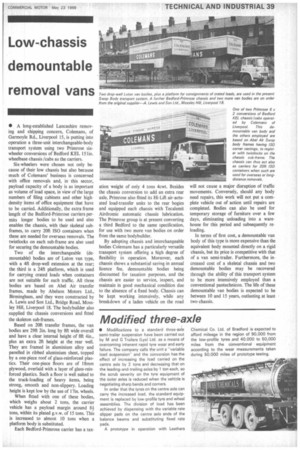Low-chassis demountable removal vans
Page 41

If you've noticed an error in this article please click here to report it so we can fix it.
• A long-established Lancashire removing and shipping concern, Colemans, of Garmoyle Rd., Liverpool 15, is putting into operation a three-unit interchangeable-body transport system using two Primrose sixwheeler conversions of Bedford KEL 151in. wheelbase chassis/cabs as the carriers.
Six-wheelers were chosen not only because of their low chassis but also because much of Caimans' business is concerned with office removals and, in this sector, payload capacity of a body is as important as volume of load space, in view of the large numbers of filing cabinets and other highdensity items of office equipment that have to be carried. Additionally, the extra frame length of the Bedford-Primrose carriers permits longer bodies to be used and also enables the chassis, with their skeletal subframes, to carry 20ft ISO containers when these are needed for overseas removals. The twistlocks on each sub-frame are also used for securing the demountable bodies.
Two of the interchangeable (demountable) bodies are of Luton van type, with a 4ft drop-well extension at the rear; the third is a 24ft platform, which is used for carrying crated loads when containers are not suitable for such traffic. All three bodies are based on Abel Air transfer frames, made by Abelson Motors Ltd., Birmingham, and they were constructed by A. Lewis and Son Ltd., Bridge Road, Mossley Hill, Liverpool 18. The bodybuilder also supplied the chassis conversions and fitted the skeleton sub-frames.
Based on 20ft transfer frames, the van bodies are 29ft 2in. long by 8ft wide overall and have a clear internal height of 8ft 4in., plus an extra 2ft height at the rear well. They are framed in aluminium alloy and panelled in ribbed aluminium sheet, topped by a one-piece roof of glass-reinforced plastics. Their one-piece floors are of 18mm plywood, overlaid with a layer of glass-reinforced plastics. Such a floor is well suited to the truck-loading of heavy items, being strong, smooth and non-slippery. Loading height is kept low by the use of 17in. wheels.
When fitted with one of these bodies, which weighs about 2 tons, the carrier vehicle has a payload margin around tons, within its plated g.v.w. of 15 tons. This is increased to almost 10 tons when a platform body is substituted.
Each Bedford-Primrose carrier has a tax
ation weight of only 4 tons 4cwt. Besides the chassis conversion to add an extra rear axle, Primrose also fitted its Hi-Lift air-actuated load-transfer units to the rear bogies and equipped each chassis with Tecalemit Airdrornic automatic chassis lubrication. The Primrose group is at present converting a third Bedford to the same specification, for use with two more van bodies on order from the same bodybuilder.
By adopting chassis and interchangeable bodies Colemans has a particularly versatile transport system offering a high degree of flexibility in operation. Moreover, each chassis shows a substantial saving in annual licence fee, demountable bodies being discounted for taxation purposes, and the chassis are easier to service, inspect, and maintain in good mechanical condition due to the absence of a fixed body. Chassis can be kept working intensively, while any breakdown of a laden vehicle on the road
will not cause a major disruption of traffic movements. Conversely, should any body need repairs, this work will not put a complete vehicle out of action until repairs are completed. Bodies can also be used for temporary storage of furniture over a few days, eliminating unloading into a warehouse for this period and subsequently reloading.
In terms of first cost, a demountable van body of this type is more expensive than the equivalent body mounted directly on a rigid chassis, but its price is competitive with that of a van semi-trailer. Furthermore, the increased cost of a skeletal chassis and two demountable bodies may be recovered through the ability of this transport system to be more intensively employed than a conventional pantechnicon. The life of these demountable van bodies is expected to be between 10 and 15 years, outlasting at least two chassis.
































































































































